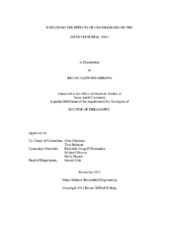| dc.description.abstract | Crosslinking soft tissue has become more common in tissue engineering applications, and recent studies have demonstrated that soft tissue mechanical behavior can be directly altered through crosslinking, but increased understanding of how crosslinking affects intervertebral disc mechanical behavior is needed. In vitro testing of bovine disc and motion segments was used to characterize several important aspects of disc behavior in response to crosslinking after both soaking and injection treatment.
The first study was a comparison of different crosslinkers to determine the effect on tensile properties of disc tissue. Circumferential specimens were taken from bovine annulus and then soak treated with an optimized crosslinking formulation or sham solution. A non-contacting laser micrometer was used to measure cross sectional area, after which tension testing until failure was performed to determine yield strain, yield stress, ultimate stress, peak modulus, and resilience. The crosslinkers were observed to produce different changes in the properties, with the measured properties generally increasing.
The second study used bilateral annular injections to simulate a clinically relevant delivery method. The dose response of the motion segment’s neutral zone stability metrics against injection concentration was mapped. Concentrations of 20 mM and less had no significant effects on the stability metrics. 40mM demonstrated a change in neutral zone stiffness, while at least 80mM was required to significantly affect neutral zone length. Thus, meaningful changes in joint neutral zone stability were demonstrated using clinically relevant injection and chemical formulations.
The third study used combinations of biochemical and accelerated mechanical cyclic loading to degrade gelatin and annulus fibrosus specimens with and without genipin treatment. Genipin crosslinking attenuated changes during cyclic loading to specimen geometry and compliance relative to control samples. Full recovery of genipin treated samples appeared to be hampered, at least partially from continued crosslinking during the accelerated testing.
The fourth study tested the effect of genipin crosslinking to resist interlamellar shearing of the annulus lamella. Using a recently reported test method that shears adjacent lamella, crosslinked specimens were noted to have significantly higher yield force, peak force, and resilience compared to sham treated controls, supporting the hypothesis that crosslinking would increase the load bearing ability of the interface. | en |


